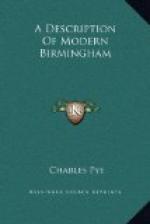[Footnote 5: A blast furnace, for the making of pig iron, very near at hand.]
You now cross the Bourn, a small stream of water, that separates Warwickshire from the county of Stafford, and passing by Mr. Boulton’s plantations on the left, when you are about half way up the hill, there is on the right hand, Prospect-house, where the late Mr. Eginton carried on his manufactory of stained glass.
At the two mile stone, on the left, is the entrance to Soho, where Matthew Robinson Boulton, Esq. resides, who is proprietor of the Soho Manufactory.
The road leading to this magnificent pile of building is on the left, when you have passed through the turnpike. The spot upon which it is erected, was, in the year 1764, a sterril, barren heath, and so it continued until 1793, when it was inclosed by act of parliament. The late Mr. Boulton, in the first instance, expended more than nine thousand pounds in the erection of buildings, exclusive of machinery. He soon after removed his manufactory from Birmingham; and then this enterprising genius established a seminary of artists; men of ingenuity being sought after, from all parts of Europe, and patronised with the greatest liberality: thus fostered by his benevolence, they soon produced an imitation of the or molu.—These metallic ornaments in the form of vases, tripods, candelabras, &c. found a ready sale, not only in this kingdom, but in France, and almost every part of civilized Europe. This business being established, silver articles were manufactured in such profusion, that it became necessary to make application for an assay office to be established in Birmingham; which was carried into effect in the year 1773. About this time, a mechanical process was discovered of copying pictures, in oil colours, which was brought to such perfection, that the most experienced connoiseurs were sometimes deceived. The process was chiefly under the direction of Mr. Francis Eginton, who afterwards commenced the business of staining glass.
Mr. Watt having obtained a patent for the improvement of steam engines, came and settled at Soho, in 1769, where he erected an engine, upon his own principles; which answering the intended purpose, he in 1775, obtained from parliament a prolongation of his term for twenty-five years. A partnership being now formed between Mr. Boulton and Mr. Watt, an extensive manufactory of these engines was established at Soho, and conveyed from thence to most of the deep mines and extensive works, where great power was requisite.




